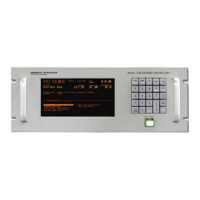TRACKING TUTORIAL
D-2
To enter the date and time into the system, select Await mark... and the
following message appears:
System UTC date and time will be set to
hh:mm:ss dd Mmm yyyy (Note: the time and date just entered will be
displayed.)
when [ENTER] is hit.
Press [PRIOR] to cancel.
Press [ENTER] to enter the date and time into the system. Press [PRIOR]
twice to return to the Main menu.
The next step in the procedure is to calibrate the look angles. This requires
pointing the antenna at a known position so that the encoder offsets can be set
properly. Normally this known position will be a well station-kept satellite or one
for which a calculated ephemeris can be obtained.
3. Approximate the antenna’s current position. Estimate the antenna’s azimuth
angle using a reference such as a compass or platform centerline; to facilitate
this, manually move the antenna, if necessary, with Main menu, Tracking
functions…, Manual antenna control…. Estimate the elevation using a
reference such as a mechanical inclinometer. The more accurate these
estimates are, the easier it will be to peak on the first satellite. Go to Main
menu, Edit system configuration..., Position encoder configuration..., Current
position [deg] and enter these values.
4. Identify a stable satellite which has a known nominal longitude or box center in
the operational region of the antenna. Go to Main menu, Tracking functions…
to point the antenna at the satellite. This can be done with Manual antenna
control… or automatically with Immediate tracking… To do it automatically,
select Edit immediate target…, and select Tracking mode. Use the arrow keys
to select the desired mode and [ENTER] to pick it; select “Move to longitude”,
or “Move to look angles” if published values are available. Select Edit target
parameters… Depending on the choice of tracking mode, either enter the
nominal longitude in the E. Longitude of target [deg] field (negating for West
longitude) or the published azimuth and elevation in the Look angles [deg] field.
In either case, Bias angles [deg] should be set to zero. Exit the menu and save
the changes. The ACS is now ready to make the first attempt at pointing to a
satellite. From the Immediate tracking menu select Track immediate target;
verify the target information before the final confirmation to begin tracking.
5. Peak the antenna on the satellite (possibly using a receiver or spectrum
analyzer). To find the satellite sweep azimuth because its estimation is usually
less accurate than for elevation. Swing through the peak to make sure it is the
main beam, not a sidelobe; peak both axes. Be careful not to peak on an
adjacent satellite; The satellite may be verifiable with a TV receiver or
spectrum analyzer. A TV receiver may be used to look for satellite
identification or to compare its transponder output with published

